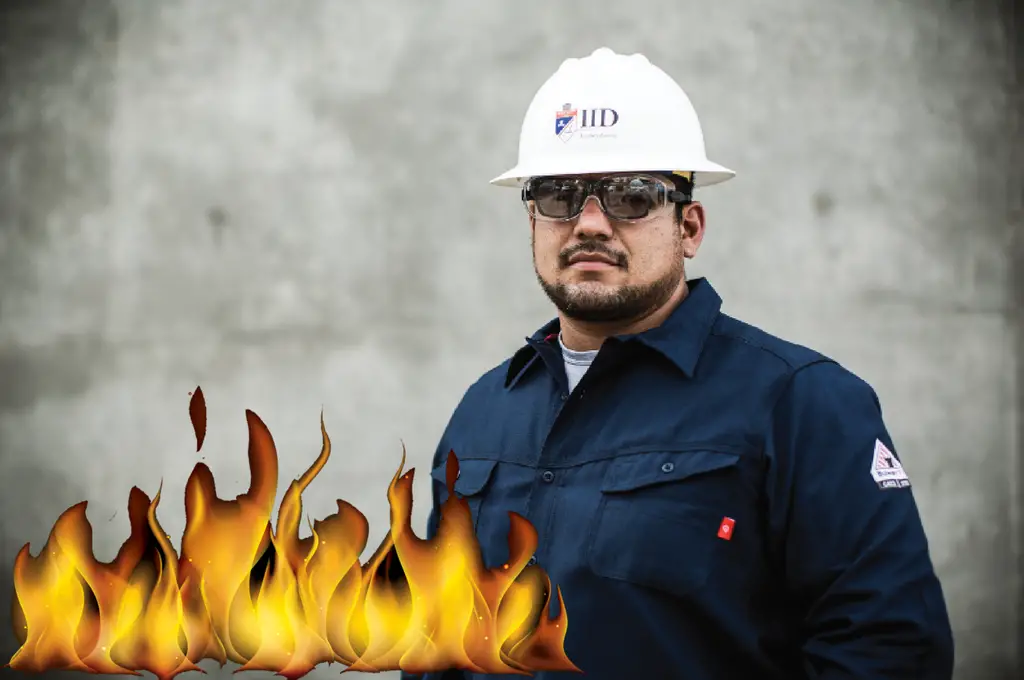Cotton is probably the most popular and desirable of all natural fibers with a rich history and inspiring saga dating back to centuries.
The comfort it provides and the very feeling the material provides makes it one of the most sought after fabrics out there. Be it formals, casuals or workwear, cotton clothes do have a strong fanbase.
We have indeed heard lots and lots of praises devoted to the breathability, lightness and comfort of cotton but how exactly would 100% cotton fare in a workplace with the risk of fire hazards.
Is 100% cotton a perfect fit when fire accidents are involved or are they just not up to the task? Read on to find out.

Is 100% cotton fire resistant?
The belief that 100% cotton is fire resistant is nothing but a blatant misconception. 100% cotton will definitely burn when it is exposed to fire but untreated heavyweight 100% cotton does resist the tendency to go up in flames.
Therefore in such a situation when there’s just a minor exposure to a few sparks or flames the attire would not catch fire, but if there’s a real full-fledged fire at your work place the flame-resistance would not really be there to save your skin.
100% cotton:- Flame resistance vs Melt resistance
Untreated cotton is definitely not the best choice for workplace when there is fire hazard involved. If an arc flash occurs the 100% pure cotton garment will catch fire and would continue to burn against the skin.
Since the material would burn without leaving behind molten residue like synthetic fibers the chance of getting high grade burns because of the molten fiber sticking on to the skin can be written off.
But the untreated cotton clothing would provide no protection from the raging flames around you and hence is not at all a suitable choice of outer or inner work wear when it comes to occupations including high risk of fire related accidents.
See also: Are Jeans Flame Resistant?
Are 100% cotton garments OSHA approved?
The OSHA requirement was that the attire of the workers do not harm them during the course of a fire. But some of cheeky employers who chose to save a few bucks distributed work wear made of melt-resistant natural fibers like cotton, silk, wool etc instead of flame resistant materials.
Even though these natural fibers do not stick on to the body of the work and cause harm, they do not provide any protection either.
Since most of the workplace accidents involved bodily harm that was caused by the work wear catching fire and burning the worker, OSHA was forced to rework the mandate.
OSHA published the final revised rule in April 2014, and made it mandatory that the employer should provide full fire resistant work wear to the employees taking into consideration the level of risk of fire hazard at the workplace.
From this mandate that has been in practice from August 2015, OSHA makes it clear that the outerwear must compulsorily be fire resistant.
The inner layers could be of any material but using flammable materials is indeed discouraged as it increases the chance of burns and injuries.
Therefore OSHA do not approve of 100% cotton garments at workplaces that do pose the threat of fire accidents.
Can one use 100% cotton inner layers at work when there’s fire hazards involved?
100% cotton is a flammable fiber and would catch fire even if there is an exposure as low as 4-5 cal/cm² and would continue to burn as long as the flame is forcible put out.
In case of an arc explosion there is a high risk of these garments going up in flames and therefore 100% cotton is something you should avoid completely when there is a risk of fires at your workplace.
Be it inner layers or undergarments, it is better to opt for fire resistant materials so as to ensure your safety and well-being at your workplace.
Flame resistant materials for workplace
Flame resistant materials can broadly be categorized into two: Inherently Flame Resistant fabrics(IFR) and Flame Retardant Treatment fabrics(FRT). IFR as the name denotes are fabrics that naturally possess the chemical and structural qualities required to be flame resistant.
IFR fabrics can be made with fibers such as polyester by paying attention to the weave pattern, so as to increase the time required to melt. on the other hand, are fabrics that are chemically treated to make them flame resistant.
FRT is cotton/nylon fabric that is made flame resistant with the addition of certain chemical components. These flame resistant materials will resist ignition and in case of accidental ignition would cease burning once the source of ignition is removed from its contact.
It is applicable to use outer layers, inner layers and undergarments made of fire resistant fabrics so as to ensure your safety.
Many people are often worried about the discomfort that arises from staying inside thick layers of workwear that can cause immense exhaustion, but there are indeed good quality fabrics available in the market that can kick that apprehension out of the way.
Lenzing FR®, Nomex®, Cotton, Kermel® and Wool are some of the fabrics that are used to make flame resistant fabrics that will help maintain your body temperature without causing overheating, fatigue and discomfort.
Things to remember while getting FR work wear
The right FR attires must be chosen depending on the level of protection it provides and the ease of use and the comfort it provides to the wearer. The ease with which the workers can move in these FR attires should also be considered while purchasing them.
It is always suitable to get FR gear that is one size larger than usual for improved air flow and better comfort and heat n sweat dissipation.
If the FR garments are laundered with care and in accordance to the guidelines provided by the manufacturer, they will certainly protect and serve you longer.
How to prevent fire hazards at workplace?
Even if you are wearing FR workwear or are working in an environment where there is low risk of fire accidents it is good to keep in mind these few tips to make sure that you stay safe and prevent any fires from breaking out.
1.) Minimize clutter and make sure that the fire exits are easily accessible to everyone at all times.
2.) Ensure regular and proper maintenance of machinery and electrical items.
3.) Ensure that chemicals or flammable substances are safety stored without any contact to sparks, flames or live wires.
4.) Maintain easy access to the All Electrical Control Panel and Fire alarms.
5.) Make sure that the employees, employers or visitors only smoke in the allotted area.
If you can indeed ensure that the above mentioned guidelines are followed at your workplace, you will be able to prevent fires and minimize damage is one occurs despite all the precautions taken.







